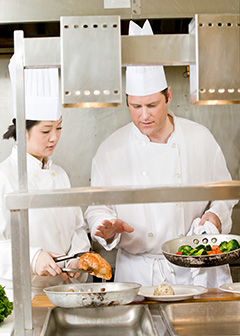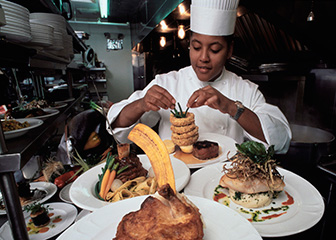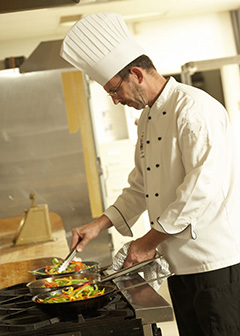
The majority of chefs are trained on the job.
Most chefs acquire their skills through work experience. Many others, however, receive formal training at a community college, technical school, culinary arts school, or a 2-year or 4-year college. A few learn through apprenticeship programs or in the armed forces.
Work Experience
Most chefs and head cooks start working in kitchens in other positions, such as line cooks or dishwashers, learning cooking skills from the chefs they work for. Many spend years working in kitchens before learning enough to get promoted to chef or head cook positions.
Education
A growing number of chefs and head cooks receive formal training at community colleges, technical schools, culinary arts schools, and 2-year or 4-year institutions. Students in culinary programs spend most of their time in kitchens practicing their cooking skills. These programs cover all aspects of kitchen work, including menu planning, food sanitation procedures, and purchasing and inventory methods. Most formal training programs also require students to get experience in a commercial kitchen through an internship, apprenticeship, or out-placement program.
Apprenticeship
Formal apprenticeship programs sponsored by professional culinary institutes, industry associations, and trade unions in coordination with the U.S. Department of Labor, also are common. Apprenticeship programs generally last about 2 years and combine classroom training and work experience. The American Culinary Federation accredits more than 200 formal academic training programs at post-secondary schools and sponsors apprenticeships around the country.
Training
Some chefs and head cooks train in mentorship programs, where they work under the direction of experienced chefs. Executive chefs, head cooks, and sous chefs who work in fine-dining restaurants have many years of training and experience.
Some chefs receive formal training through the armed forces or from individual hotel or restaurant chains.
Certification
Although not required, certification can show competence and lead to advancement and higher paying positions. The American Culinary Federation certifies pastry professionals, personal chefs, and culinary educators in addition to various levels of chefs. Certification standards are based primarily on work-related experience and formal training. The minimum work experience for certification can range from 6 months to 5 years, depending on the level of certification.
Important Qualities
Business skills. Executive chefs must understand the business of restaurant work. They should be skilled at administrative tasks, such as accounting and personnel management, and be able to manage a restaurant efficiently and profitably.
Creativity. Chefs and head cooks need creativity to develop and prepare interesting and innovative recipes. They must be able to use different ingredients and create appealing dishes for their customers.
Leadership skills. Chefs and head cooks must have the ability to motivate kitchen staff and develop constructive and cooperative working relationships with them. Because the pace in the kitchen can be hectic during peak dining hours, chefs must be able to communicate their orders clearly and effectively.
Manual dexterity. All chefs and head cooks need excellent manual dexterity, including proper knife techniques for cutting, chopping, and dicing.
Sense of taste and smell. All chefs and head cooks must have a keen sense of taste and smell in order to inspect food and design meals that will be to customers’ liking.
Time-management skills. Chefs and head cooks need to be able to efficiently manage their time and the time of kitchen staff. They must have menus ready when kitchen staff start preparing meals. And when customers are waiting for food, they must keep the kitchen running efficiently.









